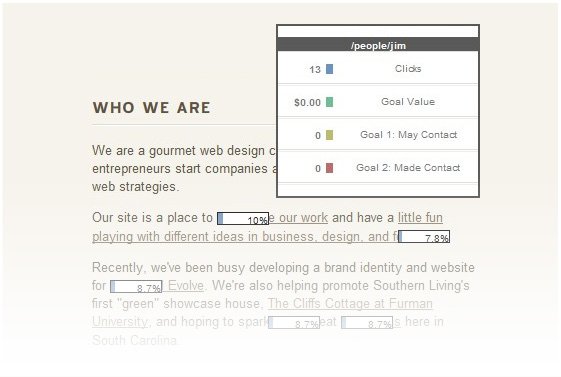The Power and Goodness of Analytics
In this edition of WWYSYDH we explore Google Analytics
Executive Summary
In short, Analytics provides anonymous tracking and reporting of site visitors and how they interact with your website.
Assuming you look at what it's tracking, you can gather neat insights, trends, and answers. This can help with your marketing strategies or just make you feel more/less popular.
I have little experience with the wide range of free and pay stats programs, so I'm not going to compare them. At any rate, we use Analytics at OC because it's likely the most simple, yet advanced, free tracking program currently available.
The Nitty Gritty
Some unique or key features:
- Absolutely Free
- Simple setup - copy and paste code into your site, click verify, and you're done.
- Very visual - line, bar, and pie charts. Timelines like on Google Finance
- Near-zero load on your web server - aside from adding 417 bytes to your page, all the processing is done by the Google server and the visitor's browser. If you use gzip (future article) it becomes even smaller.
- Customizable, dashboard for quick visual checkup
- Zero storage of log files - not usually a big problem, but I've seen log files fill up hard drives numerous times in my previous life in IT
- New tracking code also works on https:// pages (i.e. SSL)
- Integrates in some conversion-type results for your active Google advertising campaigns
- Allows for easy sharing of stats with anyone with a Google account
- Works with Google Apps accounts for easy permissions within your company
- Track multiple sites per account
- Uses a slick AJAX interface
- Benchmark your stats against your particular industry averages
- Export to PDF, XML, CSV (Excel), TSV
- Track goals - how many times did someone get here with keyword A and reach page Z
- Overlays your actual web pages with %click for each link. I must say, it's new to me and it's pretty sweet
- The overlay percentages can be a bit misleading if you have the same link more than once per page, like in both the header and footer.
- Don't be confused by off-site links. If you link to http://www.example.com/ its overlay % is actually showing the results for clicks back to your homepage which is also
Overlay Example

- Integrates in Google Site Search data, if you install it to allow visitors to search your site's content
- Schedule automatic emails of exported reports daily, weekly, etc.
- Visitors stats are pretty standard, though the Flash Version breakdown and display of visitors by their ISP name, not IP address, was new on me
- It shouldn't interfere with your existing stats programs
Life lessons
- People use the "Back to top" links at the bottom of the page, even on short pages.
- Josie is more popular than me :(
4 Comments
John, that's a good point. Here's a blog post discussing the disparity between what Google Analytics reports and what raw server stats produce. There's also a discussion at Web Master World about the differences between Google Analytics and the various other statistics tools. Bottom line is that no web statistics are perfect. If you want to achieve the best approximation, use several tools, account for outliers and anomalies then average the results.
Ah ha, my first blog challenge.
I'd say it's hard to argue one package is more accurate than another. They're all computer programs, so if functioning correctly they should do as directed. I'd suggest the difference in assumptions made by the stats packages should explain much of the difference.
I stick by my claim of limited expertise in web stats. For demonstration purposes I took another look at Analytics and Awstats and John is correct about pretty large discrepancies. However, these should be explained by a number of factors, like:
- Awstats may include search spiders / bots as visitors, whereas Analytics does not count them. This would seem to be amplified as the number of pages or crawl rate increase. Sites with thousands of pages that are spidered many times a day would see a more pronounced difference.
- Javascript disabled browsers - though a small difference, Analytics relies on Javascript, so account for the ~ 1% of users with no Javascript.
- Page views are calculated quite differently, as is evident by Awstats including things like embedded Flash (.swf) files as a page view
More on Google Analytics vs. Awstats
When absolute numbers are needed it seems wise to investigate exactly how the program is deriving the numbers and go with the package that matches what you're looking to convey with those numbers.
As they say, "Lies, damned lies, and statistics".
"Facts are stubborn, but statistics are more pliable." - Mark Twain
Lovingly crafted by orangecoat with some rights reserved, and a promise not to spam you.
Back to top
Google Analytics doesn't match server level statistics by a wide margin. It's great with the small flaw that it's highly inaccurate.